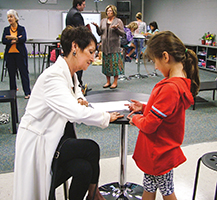Moving Women Up the District Ladder
June 01, 2017

Tamu Lucero, assistant superintendent in the 16,200-student Stamford Public Schools in Connecticut, was clearly moving on a fast track. She became a principal in Columbus, Ohio, at 26, inspired by the idea that “as an administrator, I could affect more children,” she says. “That stuck with me.”
So when her husband, who works in educational technology in another Ohio district, spotted a promotional notice on the AASA website about the association’s upcoming Women’s Leadership Consortium, he encouraged his wife to apply.
The AASA initiative, funded through a $450,000 grant from the Bill & Melinda Gates Foundation, addresses the barriers to women reaching the superintendency and provides a network of support for aspirants. The consortium, launched in 2016, positions leaders in education and business as mentors to women seeking top posts leading local school districts. Through regular phone and e-mail contact and technology-assisted meetings, the coaches help the mentees complete projects relating to organizational leadership.
Statistical Quandary
Anyone who wonders why a program targeting women educators who aspire for higher office should be needed in 2017 ought to just consider the current numbers. AASA’s “Study of the American Superintendent: 2015 Mid-Decade Update” said women held 27 percent of the nation’s superintendencies, most in smaller rural and suburban districts. In 2000, that figure was 13 percent. By contrast, women today comprise 76 percent of K-12 teaching posts and 52 percent of all principalships nationwide, according to the National Education Association.
“You would think in 2017 the playing field would be even, and women would be able to secure senior positions in districts,” says Deborah Jewell-Sherman, professor of practice at the Harvard Graduate School of Education. However, she cautions, “There’s still a great deal of work needed to secure the position and a need for support in the position.
Many women still feel that unless they can check off every qualification for a superintendent job — managing a large operating budget, bringing a significant building project to completion, serving as a high school principal or as an assistant superintendent in pupil services or instruction and assessments — there’s no point even applying. It’s not that different from what classroom teachers often observe when girls sit quietly in class, raising their hands to contribute only when they’re certain of the answers while male classmates will shout out answers even when they don’t know them
“You can surround yourself with talent,” says Melody Schopp, South Dakota’s secretary of education and a mentor in AASA’s program. “You don’t have to know everything. You need to walk into a room and own it.”
The AASA initiative, says Amy F. Sichel, a former AASA president and superintendent of the 8,000-student Abington, Pa., schools, “is really important to aspiring women. You can’t forget aspiring men, but … if you look at the tradition [of selecting superintendents,] women usually have a slower, longer route along the way. The reality is that there are the childbearing years, when it’s easier not to be in the top position.”
The value of a woman-centered program, adds Jewell-Sherman, a former superintendent in Richmond, Va., is “there are nuances that women have to provide or think about differently. Being with a group of women enables a critical analysis of their own behavior in a situation.” Women may face a subordinate who challenges their leadership or a school board president who thinks a woman will be easier to manage or manipulate. Managing the politics of the local community also can differ by gender.
Missionary Zeal
When many school boards consider potential district leadership candidates, they often look at applicants who’ve served as high school principals (perhaps with an athletic coaching position in their background, which aligns with men’s career paths). Women more commonly have been elementary school principals or worked in central-office administration
“There’s a pathway that’s come out of men’s lives,” says Margaret Grogan, dean of the College of Educational Studies at Chapman University in Orange, Calif., who has worked with AASA on this initiative. She sees unconscious beliefs affecting decisions, noting, “A lot of school boards didn’t see a lot of women in professional roles.”
That’s a concern for Judith Minor, an associate superintendent in Community Unit School District 308, an 18,000-student district in Oswego, Ill.
“There’s a certain perception that you follow certain tracks” to school leadership, says Minor, who began her educational career as a substitute teacher in the Department of Defense schools on a U.S. military base in Germany where her husband was stationed. Her earlier professional life was in the newspaper and magazine industry.
Minor’s mentor is Schopp, the chief state school officer in South Dakota who has worked in education for 23 years. It’s a fortuitous pairing because both have taken unconventional paths to educational leadership. They’ve discussed how to roll out online learning across schools, as well as the status of Minor’s career pursuits. Schopp, who spent nine years on the school board in Lemmon, S.D., helps her mentee prepare for interviews and for working with different types of boards. They use technology to communicate later at night, and Minor uses Google Docs to share her progress on assignments relating to the AASA consortium.
Schopp says she has made it a mission to grow the number of women superintendents. She was frustrated while attending a statewide meeting of high school principals to discover only one woman in the group of 40. Even though three of her state’s largest districts have been led at one point by women superintendents, the reality is that “a strong male cohort can be intimidating.”
Schopp adds, “I’ve had to break that on my own. I had a male superintendent verbally challenge me at a superintendent convention, (saying) ‘you have no idea what you’re doing and no idea what you’re talking about.’ He felt empowered to say that. As women, we have to learn not to be intimidated.”
As Minor moves forward on her career path, Schopp wants to ensure she has opportunities to have a larger impact on state and national education issues. Minor already has testified to the Illinois State House and Senate Education Committees to obtain a waiver for online learning for high school students.
With both of her mentees, Schopp discusses the most difficult leadership challenges they are likely to confront, such as “making difficult budget cuts, where we’ve talked about ways to be open and transparent.” One of her charges, an assistant principal, had to deal with a parent who accused her of not handling a situation properly, only to find that she didn’t have the support of her principal.
“You’re being tested all the time,” says Schopp. “This mentee has proven herself. She needs to be mindful of the types of support that are needed.”
Paying Forward
That’s one of the important values of AASA’s initiative, says Grogan, co-author in 2011 of Women and Educational Leadership. “It’s important to talk to women who are already in these roles, to know that someone didn’t get a job, or got fired.”
Being able to help other women motivated Sichel, now in her 17th year as a superintendent, to become a mentor.
“I really had no women mentors available to me,” she says, other than a trio of women who preceded her as AASA presidents and acted as unofficial mentors. When Sichel became superintendent in her suburban Philadelphia district in 2001, only three women were superintendents in her region. Now eight of the area’s 22 districts are led by females.
The two women she is coaching are both district-level directors, one overseeing curriculum and the other, elementary education. During Google hangouts, says Sichel, they discuss superintendent and board relations and the need for women to be “assertive and work around obstacles.” She shares advice on how to manage committee work as a way to delegate, but also how to be in charge and “make cogent presentations,” even how to dress like a CEO.
A Comfort Level
It’s these powerful mentor/mentee relationships that distinguish the Women’s Leadership Consortium, participants in both roles attest. Take Lucero’s experience. She had maintained strong, ongoing relationships with the superintendents under whom she had worked in Ohio, yet she saw a potential benefit in “having a mentor who doesn’t know me and can see something different in me. We can dig into different areas.”
Even though her mentor, Judith Rattner, is a superintendent of a school district in New Jersey that’s five times smaller than hers in Connecticut, “the problems are the same,” says Lucero. “I have a laundry list of things I’m working on — building a new school, budgeting, special education, being efficient in providing support.”
Some issues, such as managing struggling English language learners, dealing with parents of high school seniors who don’t have enough credits to graduate or developing a community of practice for principals, transcend district profiles.
Rattner, a superintendent for 12 years who has served in an array of leadership posts in her state’s professional association, has discussed with Lucero her next step as she pursues a district of her own to lead. Lucero says she’s been encouraged to “talk about a district that’s a good fit. … [I]t’s a calling to be an educator. It’s a lifestyle. We believe in living in the community we’re working in.”
Lucero believes she’ll continue to reach out to Rattner because of the comfort level she’s established “if I’m ever struggling.” Or, she adds, “I may run something by her to get her thoughts. It’s the best form of professional development, with coaching that’s specific to you. It’s invaluable. I can’t get it somewhere else.”
Author
Advertisement
Advertisement
Advertisement
Advertisement



